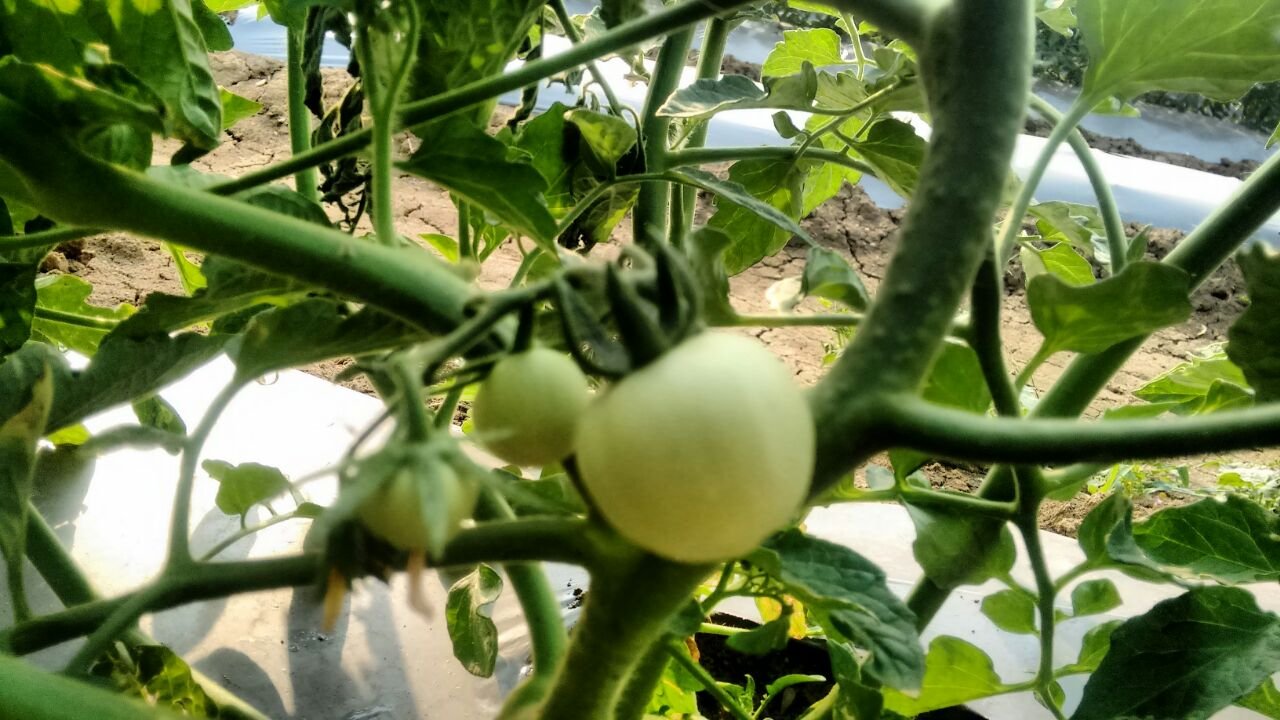The Lanky Tomato Saplings
Story and photos from: Madhukar Swayambhu, Founder & Research Head, Vaidic Srijan LLP, a member of CA4SH from Bharat (India), +91-9650667668, swayambhu@vaidicsrijan.com
Cownomics® Technology, rooted in ancient Indian Vedic sciences focuses on the resurrection of native ecology in soil, water and air. Madhukar Swayambhu, Founder & Research Head, Vaidic Srijan LLP, shares a case study of the transformation of crops by enriching the health of Soil, Water and Air by creating a farm-level microclimate transforming the farm to chemical-free practices that are disease, pest and weather resilient. This is the story of the Lanky Tomato Saplings.
Background
Tomato saplings arrived on a farm in Bharat, India on the 30th of January, 2018, and were accidentally kept in a greenhouse for longer tan expected. Unfortunately, the planting was postponed by a day, enough for the saplings to grow lanky with an imbalanced root-shoot ratio. While the root was still small, the shoot elongated so much that it couldn’t stay upright on its own. The farm owners were so sure the plants wouldn’t make it that they had already ordered a new lot to replace them, but as this is an expensive fix, they were looking for an alternative solution.
This is when the Sustainable Symbiotic Farming Methodology (in conjugation with Cownomics® Technology) was adopted on the farm.
The lanky saplings were planted, and the farmers saw day-by-day improvement across the 3-acre farm, despite the scorching heat in central Bharat, reaching 32˚C in February. All of those lanky saplings grew into firm plants within merely 3 days of early morning sprinkling (foliar spay) with rejuvenated water from the adjacent pond, which was managed using the Cownomics® technology, which involves increasing the Dissolved Oxygen content and naturalizing the water’s electrolyte balance. Since application, the growth has been consistent and perpetual, without the use of any fertilizer, insecticides or pesticides.
A video was captured on 4th February 2018 to record the health of the saplings. The day temperature was consistent at 32˚C degrees, and the weather was dry and sunny. The saplings started becoming firm and sturdy with the growth of multiple true leaves; they weren’t lanky anymore. Leaves and branches started growing denser with each day. The root-shoot ratio balanced naturally with the saplings growing into bushy plants. All of the plants appeared bright green and quite healthy by the end of the week, although while planting them the farm owners were not convinced that the saplings would survive, and thus they had ordered more saplings to eventually replace the dying ones.
Eventually, all the lanky saplings grew into tough and sturdy bushes of tomatoes - not just for one or two but the entire 3-acre tomato plantation. The farm owner had to plant the newly ordered saplings on a different plot, because all of the lanky saplings survived.
The crop survived the initial critical condition of the lanky saplings and didn’t need to compete with weeds due to the applied mulching. They have grown up to be strong young plants, but the real fight for survival had yet to begin; the fight with disease, insects, moths, pests, bacteria, viruses and fungi is what they would need to be prepared for. There are many threats to the tomato crop that push farmers to use exorbitant amounts of chemicals to compete with these challenges.
Disease & Pest Management
Physiological disorders like Blossom End Rot, Fruit Cracking, Sun Scald, Cat Face, and Puffiness are common in some varieties of tomato. Major pest problems in tomatoes are leaf curl, leaf miner and other viruses, root-knot nematodes, wilt caused by soil pathogens, fruit borers and sucking insects.
Especially leaf-miner, that’s the most common in tomatoes in this agroclimatic zone, in this season. Tuta absoluta or T Absoluta is a species of moth in the family Gelechiidae known by the common names tomato leaf-miner, tomato pinworm and South American tomato moth. It is well known as a serious pest of tomato crops in Europe, Africa, western Asia and South and Central America.
This moth was first known as a tomato pest in many South American countries. In 2006, it was identified in Spain. The following year it was detected in France, Italy, Greece, Malta, Morocco, Algeria and Libya. In 2009 it was first reported from Turkey. The advance of T Absoluta continued to the east to reach Syria, Lebanon, Jordan, Israel, Iraq and Iran. Further advances southward reached Saudi Arabia, Yemen, Oman and the rest of the Persian Gulf states. In India, Maharashtra, adjoining Madhya Pradesh and Chhattisgarh State tomato cultivations were more affected in November 2016. Recently, this pest has been identified in several districts of Nepal. In April 2017, it severely infested Myanmar as well, especially in tropical tomato-growing areas such as Mandalay, Sagaing, and Monywa.
Monthly Growth Monitoring
The next video was captured on 27th February 2018, to monitor the growth and health of the crop. The plants were now a month old and had grown into dense bushes. The leaves and branches were green enough to depict an abundance of chlorophyll, which is also an indication of a strong immune system. Flowering had already started, and bright yellow-coloured flowers could be seen in the video, amongst the green bushes of tomatoes. Plants had grown about 2 feet high, and despite attaining that height, all of them stood erect without any external support of ropes and sticks that are usually used by all the farmers in central India for tomato plantation. There were no diseases or pests observed on the entire farm.
Followed by flowering, the fruit started in the 5th week of plantation. And the first crop was ready on the 42nd day for harvesting, while usually, it took anywhere between 75-90 days, for the first crop to get ready for harvest in this agroclimatic zone. Harvesting then continued till the 114th day, while tomatoes are usually harvested in this region for only 60 days after the 1st harvest, but in this case, the harvesting was elongated till 72 days. This actually meant early flowering, early fruiting, early harvesting and elongated fruiting as well as harvesting too. It was a major boost in the yield amounting to almost 278% of the normal crop.
And then came the question of post-harvest longevity. Tomatoes are considered a highly perishable crop, usually starting to rot within 3-4 days from harvesting and therefore the middlemen get a high room for arm-twisting the farmers with negotiating the prices. Thus, post-harvest longevity was a very crucial subject for the tomatoes. Since the initial crop was 33 days ahead of any other farmer, the initial price was really good. But, as the days passed and the market started getting flooded with tomato supplies, the prices dropped. This was the time to test the crop quality because selling at a lower price was a loss to the farm owner. To the surprise of the farm owner, the post-harvest longevity of the crop was good enough for 17 days, and the tomatoes remained fresh enough to be sold in the market to secure a good price too.
Summary
To summarise – The entire crop cycle improved. Since the usual harvesting takes a minimum of 75 days to a maximum of 90 days, in this case, it was reduced to a mere 42 days, as the first harvest started on 15th March and the last harvest was done on the 25th May, which is again higher than the usual standards since the last harvest is done within 60 days of the 1st harvest that got extended by 10 days in our case.
The Sustainable Symbiotic Farming Methodology (in conjugation with Cownomics® Technology) proved to be way more profitable since the input cost of fertilizers, insecticides, weedicides, pesticides, growth hormones, enzymes etc. was all reduced to zero. The produce grew faster and for a longer duration. Yield was multiplied many times (a jump of 278% from the normal crop) and the quality was ahead of all the products available in the market, as it was all natural.
















